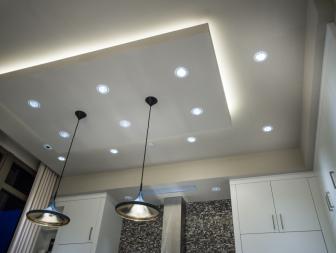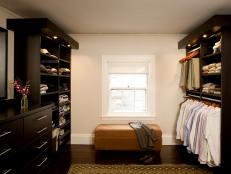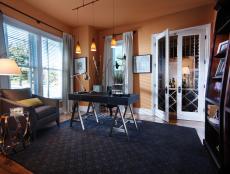Basement Lighting Options and Ideas
Whether you’re planning a home theater with indirect mood lighting or a craft space with bright work lights, we've got answers to the most common questions about lighting the lower level of your home.
Lighting a basement can be a challenge. Even if your basement is a walk-out with several windows and doors, chances are the space is probably not getting a lot of natural light. That's why it's best to make a lighting plan to assess all your needs. If you're simply redecorating, adding the right lighting can do wonders for making your space more inviting. If you are planning a full remodel, don’t underestimate the importance of consulting a lighting designer to make sure you adequately illuminate your space. You don’t want to regret not installing enough outlets and light fixtures after the remodel is complete.
We've asked lighting designers to answer some common basement lighting questions and offer design tips and ideas.
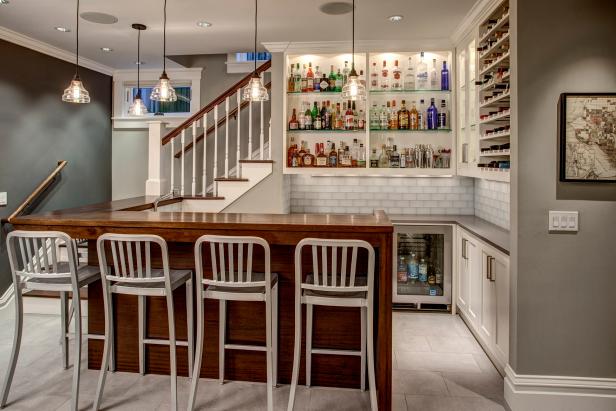
John G. Wilbanks Photography
Start With a Lighting Plan
When creating a lighting plan, the first thing to consider is function. Yes, you'll want to flip the switch at the top of the stairs and illuminate the whole space, but also consider what activities will happen in your basement and the best lighting for each of those. Then you may want to add a little mood or indirect lighting to set the tone of the space or highlight certain elements in the room.
Lighting Types
When making your lighting plan, consider the three different types of lighting and determine your needs.
Ambient or all-over lighting
These are lights designed to spread light throughout the entire space. For a basement, ambient lighting is often best achieved through recessed ceiling lights (aka — can lights, high-hats or downlights). Track lighting is an alternative to recessed lights, and it can be more budget-friendly especially if you are trying to fit ambient lighting in a finished space.
Task lighting
It is what it says it is: lighting used to illuminate a certain task. In a basement, common examples would be pendant lights over a bar, chandeliers or large hanging fixtures over a game table or dining table, under-cabinet lights in a kitchenette or reading lamps near a sofa or on a desk.
Indirect lighting
This type of lighting is more about setting a mood or highlighting architecture, artwork or collectibles. Examples include rope lighting used behind a bar or inside a shelving unit, wall sconces in a home theater room or a small light fixture hung over a piece of art.
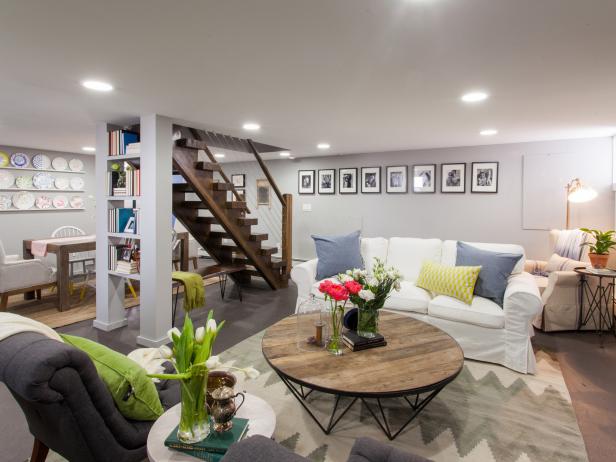
Chris Amaral
Ambient Lighting
For recessed lighting, how far apart do the lights need to be?
Standard spacing for recessed lights is normally 8 to 10 feet apart, but that will mostly depend on the size of the fixture and the function of what you’re lighting. Instead of being concerned so much about an actual distance, your goal should be even lighting throughout rather than have some areas brighter and than others. “There isn’t a standard amount of distance between the lights, however, the higher your ceiling, the less lighting you’ll need, especially when using dome-shaped lights,” explains designer McKinley Miller with FBC Remodel. “Our preference is to use disc lights that are shallower with a fiberglass or plastic covering for a more seamless look.”
How hard is it to retrofit recessed lighting into a basement not being remodeled?
If the basement is already finished, adding recessed lights can be difficult. You’ll need to cut a hole in the ceiling, ensure the correct electrical is being run to it and then connect the wiring and install the light. Cutting cut into walls and potentially relocating electrical wiring is a job best left to the pros. If you have access to the utilities in the basement ceiling – drop-ceiling panels or open rafters – naturally, the job will be much easier and less expensive.
Is track lighting a good option?
Track lighting is an excellent alternative if installing recessed lights is beyond your budget or you don't want to drill holes in your ceiling. Even if you have just one junction box in the ceiling, an electrician should easily be able to install a track unit that can illuminate a large space. If your ceiling doesn't have a junction box, you can run the cord across the ceiling and conceal it with wire molding or simply paint the wire the same color as the ceiling.
The wonderful thing about track lighting is that it can cover a lot of ground and be pointed in whichever direction you want. Track lights are also a good option in a low-ceiling basement because you can find models that will protrude less than 6 inches down from the ceiling.
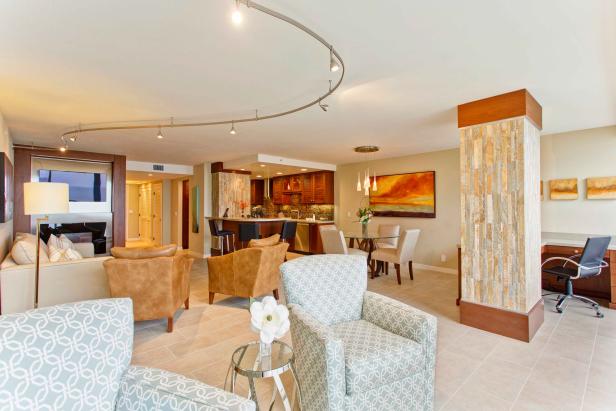
Jackson Design and Remodeling
How tall should the ceiling be to allow for ceiling fans and other types of non-recessed fixtures?
“The ceiling code minimums vary from market to market. For example, in Denver, the minimum is 7 feet, while in Chicago it’s 6 feet, 8 inches, explains McKinley. “However, when considering adding in ceiling fans and other non-recessed fixtures, you’ll want your ceiling to be a minimum 7 feet, 6 inches. This accounts for a standard 7-foot ceiling height, plus the 6-inch length of items like a ceiling fan.”
What sort of bulb is best for recessed lighting?
“The type of bulb isn’t of great importance, but our recommendation is LED,” says McKinley. Compact fluorescent lights (CFL) are also a good choice for recessed lights. Both produce a lot of light but consume less energy and give off less heat than traditional incandescent.
How to Replace Recessed Lighting
Recessed or 'can' lights can be used as task lighting, accent lighting or to illuminate an entire room. They're easy to install into existing wiring, and best of all, recessed lights don't go out of style.
Task Lighting
What's the best lighting for a bar or kitchenette?
You'll want to add task lighting in a bar or kitchenette area. Pendant lights over the countertops and under-cabinet lights will help illuminate the prep spaces as well as highlight the countertop materials, especially if you've invested in a glossy natural stone. Of course, these options are best if planned for prior to a remodel. Like recessed lights, pendants will require cutting into the drywall if retrofitting into a finished ceiling, and a drop ceiling will be less labor and cost. Under-cabinet fixtures can be plugged into backsplash outlets if unable to hardwire or battery-operated fixtures can be added. “Pendant lighting and task lighting definitely will work for a basement bar," explains McKinley. “Although not the only solution, we use those features often. What’s most important for basement bar lighting is the look and design aesthetic you’re trying to achieve. Lights really contribute to the ambiance of the basement.”
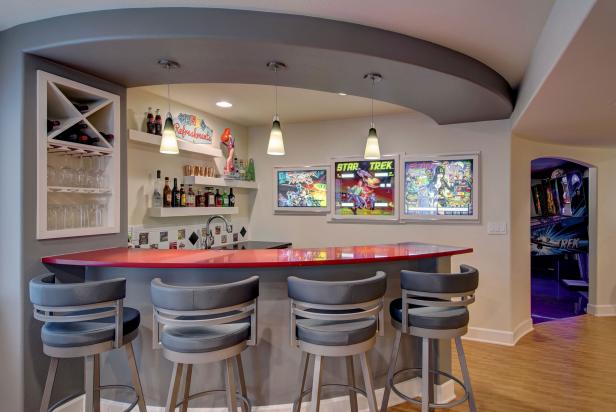
FBC Remodel
Where should chandeliers and hanging fixtures be placed?
If you have a game table or billiards table in your basement, here’s your chance to add a lot of design flair with a fancy chandelier or a modern piece of lighting. If doing a full remodel, plan ahead and make sure to position lighting directly over the game tables. If that’s not an option, go for a fixture with a large chain that can be swaged over the table. If the fixture is heavy, have a carpenter install the hooks to make sure they’re sturdy. For a dining table or game table hang the light fixture 36 inches above the table. Go a little bit lower for a billiards table, around 32 inches.
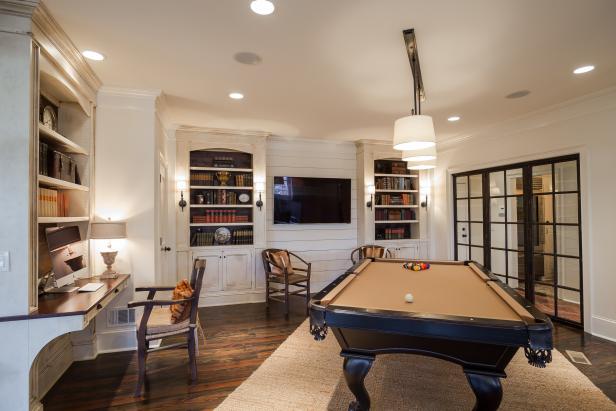
Dorsey Alston Realtors, a member of Luxury Portfolio International
What if I don't have floor outlets for lamps?
Never underestimate the power of a good table or floor lamp. Besides being able to provide the look you're going for without spending a lot of money, lamps can give you direct light exactly where you need. For a workspace or craft area, traditional desk lamps are the way to go. If you are doing an extensive remodel, you’re probably already planned for electrical outlets that meet building codes. But installing electrical outlets in a concrete basement floor can be a much bigger task you may not want to take on. A trench has to be dug to run the wiring, and if there's any chance of the basement flooding, floor outlets are not a good idea. Not having floor outlets can make it difficult to have a floating floor plan with sofa and end tables in the middle of the room. Consider furniture with built-in outlets to help bridge the gap to the nearest wall outlet. Cord concealers for walls and floors can also help bring electricity to where you need it.

Lucy Call
Indirect Lighting
What's best for highlighting collectibles or artwork?
If you want to highlight architectural features, furnishings, wall art or a display of collectibles, wall sconces can tastefully highlight a particular element as well as add style to the room’s decor. If you already have finished walls and don’t want to cut holes in them for lighting, corded sconces can be used but you may have to get a little clever when it comes to concealing the cords. Again, track lighting on the ceiling is good for highlighting design elements because they can aim pools of light directly at a focal point.
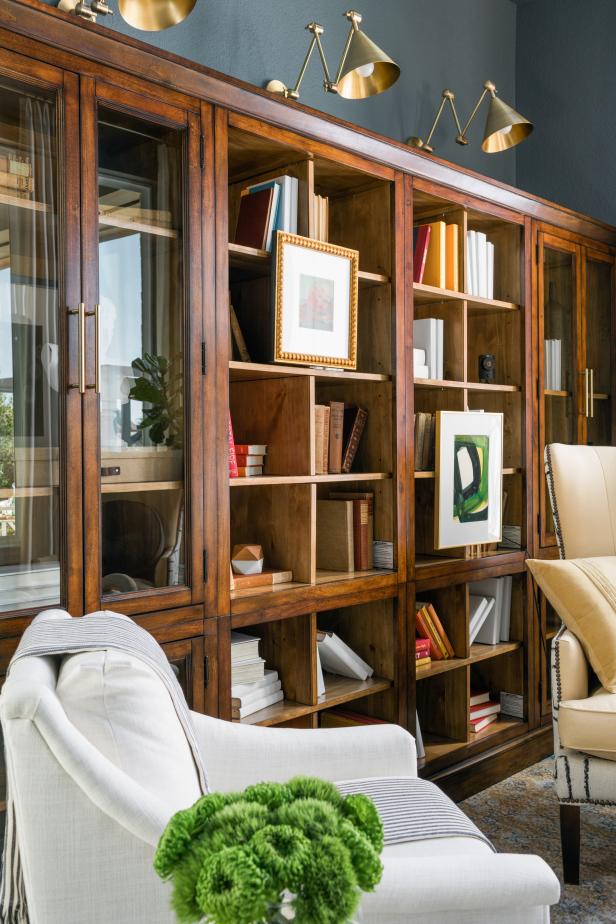
What about rope or runway lights?
For indirect lighting — like illuminating the toe-kick under the bar or in the soffit of a tray ceiling or in a stairwell — LED tape or rope lighting is a stylish and inexpensive option. LED tape is a narrow 1/4-inch strip of lights that is easy to conceal and only costs about $7 to $10 per foot. LED tape or rope lights work well in home theaters to lend just a little bit of light in the dark space.
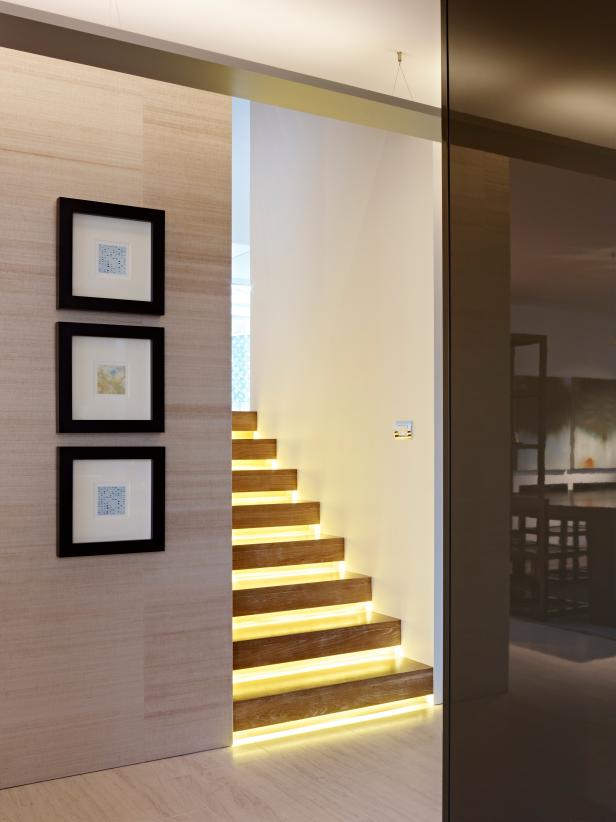
Got any suggestions for home theaters?
Besides a little ambient light, wall sconces are a wonderful choice for a home theater. If you have a ceiling projector, they won’t interfere with it or impede the view of the screen as hanging fixtures might. Places sconces equidistant along the side walls to evenly illuminate the space. If wall sconces don't jive with your decor, puck or can lights can be tucked into a soffit so that they're not visible. Use a dimmer switch on the sconces so you can turn down the lights at showtime and keep them on low during the show. Rope lighting or LED tape is a great way to illuminate the steps in a multi-level theater room.
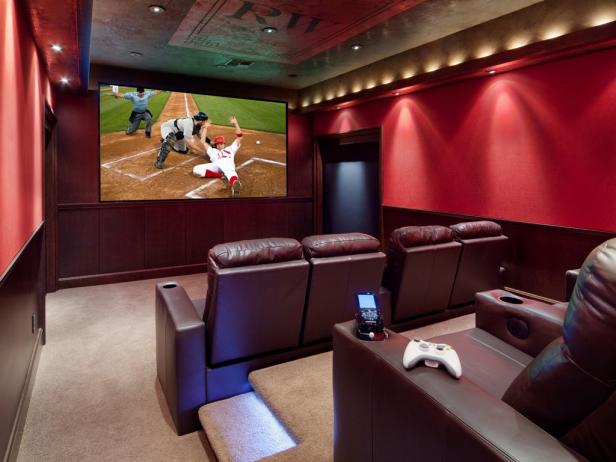
Photographer: Harvey Smith
Anything new in lighting that should be considered?
“Layered lighting is always on trend, and you can achieve that by using recessed cans and accent lights,” according to designer Lyndsay Bussler. “I’ve seen a surge in decorative lighting recently like chandeliers, sconces, etc. to add some texture and metal to the space. Oversize pendant lights are also a big deal in kitchens and wet bar lighting.”
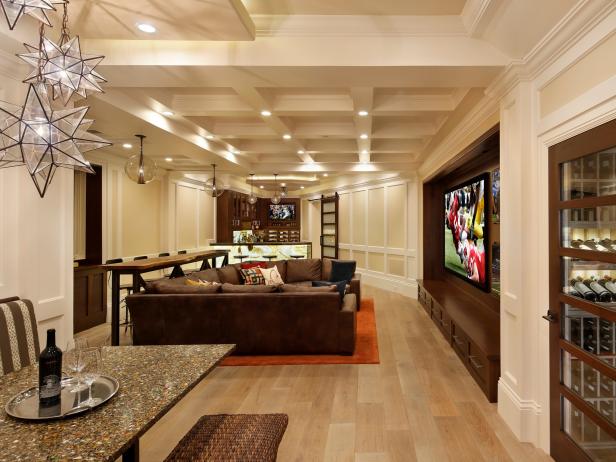
Andre Bernard
Any other suggestions?
Yes. Implement lighting that can be put on a dimmer switch so you can adjust the amount of light and the mood. Note that not all CFLs can be dimmed, but the package label should indicate if it's possible.









